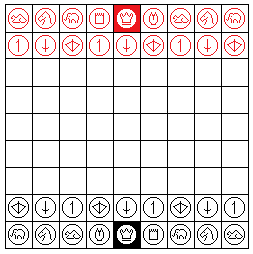
C. George Boeree
Mêlée is a Chess variation, played on a nine-by-nine board, that accentuates the pawns' role by improving and diversifying their powers. The Prince serves as King, but moves like a Queen. Additionally, there are six pieces that are capable of jumping over other pieces. On the other hand, there is only one Rook and one Bishop. The resulting game is tighter and more structural.
The pieces are Checkers-size discs, as in Xiangqi (Chinese Chess), with painted symbols (see below) in black and red. The board is of parchment paper.
The pieces:
![]() The
Prince: One per player. Moves any number of spaces orthogonally or
diagonally (like the Queen in traditional
chess).
The
Prince: One per player. Moves any number of spaces orthogonally or
diagonally (like the Queen in traditional
chess).
![]() The
General: One per player. Moves any number of spaces orthogonally
(like the Rook in traditional
chess).
The
General: One per player. Moves any number of spaces orthogonally
(like the Rook in traditional
chess).
![]() The
Bishop: One per player. Moves any number of spaces diagonally
(like the Bishop in
traditional chess).
The
Bishop: One per player. Moves any number of spaces diagonally
(like the Bishop in
traditional chess).
![]() The
Horse: Two per player. Moves one space orthogonally, then one
space diagonally, and may jump any intervening pieces (like the Knight in traditional
chess).
The
Horse: Two per player. Moves one space orthogonally, then one
space diagonally, and may jump any intervening pieces (like the Knight in traditional
chess).
![]() The
Camel: Two per player. Moves two spaces orthogonally, and may jump
any intervening pieces (the Dabbabah move).
The
Camel: Two per player. Moves two spaces orthogonally, and may jump
any intervening pieces (the Dabbabah move).
![]() The
Elephant: Two per player. Moves two spaces diagonally, and may
jump any intervening pieces (the Alfil move).
The
Elephant: Two per player. Moves two spaces diagonally, and may
jump any intervening pieces (the Alfil move).
![]() The
Sword: Three per player. Moves one space orthogonally or
diagonally (like the King in traditional chess, or like the Man).
The
Sword: Three per player. Moves one space orthogonally or
diagonally (like the King in traditional chess, or like the Man).
![]() The Pike:
Three per player. Moves one space orthogonally (the Wazir move).
The Pike:
Three per player. Moves one space orthogonally (the Wazir move).
![]() The Bow:
Three per player. Moves one space diagonally (the Ferz move).
The Bow:
Three per player. Moves one space diagonally (the Ferz move).
The Castle: A flat, square token, placed beneath the Prince at the start of the game. It does not move. See below for details and alternative starting positions.
There is no promotion, no double first move, and no castling.
The winner is the player who occupies the opponent's Castle or who takes the opponent's Prince.
Standard arrangement:

Variations:
1. The Castle may be placed on the square directly in front of the Prince. This makes it more vulnerable, and thereby shortens the game.
Or the Castle may be left out of the game, which makes for a longer game.
2. Each player, out of sight of the other, arranges his pieces as he wishes, with the following restrictions: Pikes, Swords, and Bows must occupy the second rank; Other pieces must occupy the first rank. The Castle is placed on the square upon which the Prince begins.
Optionally, the Castle may be placed on the center square of the second rank, as in variation 1, or left out altogether.
Copyright © 1999, 2001 C. George Boeree
Written by C. George Boeree
WWW page created: May 4th, 1999.
WWW page updated: May 13th, 2001.